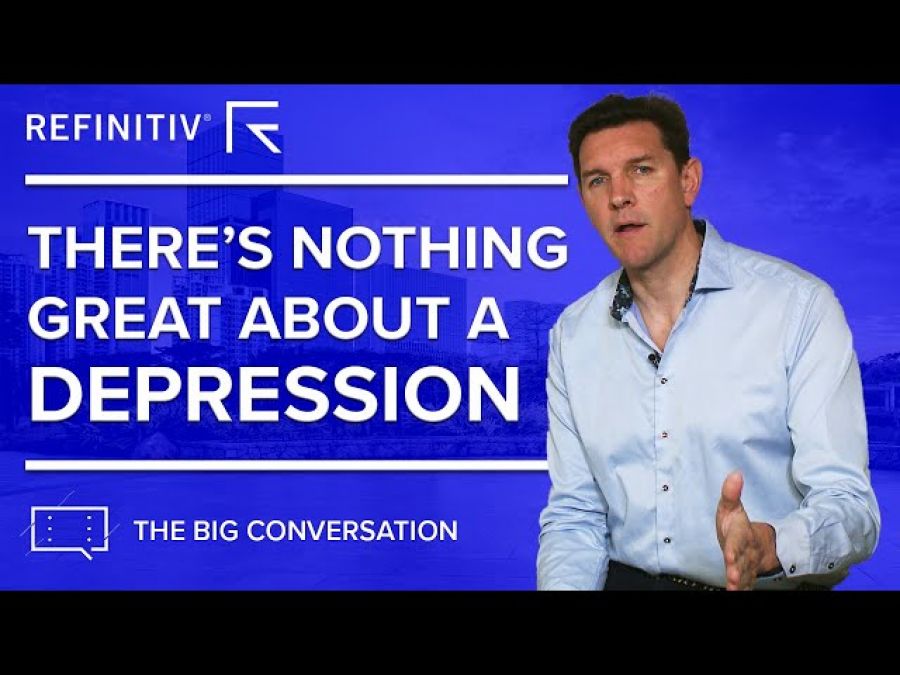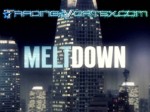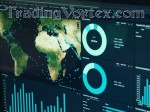Video Transcription:
The Lasting Effects of a Lockdown | The Big Conversation | Refinitiv
Global leaders have put their economies into hibernation in order to slow the rate of Coronavirus spreading. Well, a question now is will this slowdown put a floor under equity prices? That's 'The Big Conversation'. Over the last few weeks, I've been talking about how the deleveraging side of the market has probably now been done, this was the shadow banking system unwinding its excess leverage, plus the volatility funds taking off some of their positions is obviously volatility spiked. The big question now really is, have we seen the downside complete on the S&P? And I think some historical context is worthwhile here. Firstly, when we look at the moves that we've seen, yes, it's been a big move, we can see that the quarterly move, so the quarter on quarter move that we've seen on the S&P is quite dramatic. But it's not a particularly standout move when compared to history over the last 30, 40 years. And then when we look at a longer term chart of the S&P, we can see here that on a longer basis, the pullback that we've seen is, again, not particularly spectacular compared to other periods of history. In fact, this pullback that we've seen overall is probably smaller than any of the major pullbacks that we've seen since since the 1960s, 1970s that have been associated with a major recession. So we look at recessions and the S&P, we can see actually there's only really 1991 where the pullback was a small in percentage terms as the one we've seen here. This kind of goes back to whether we think that this is going to be a recession, a deep recession or a depression. And that obviously is meaningfully different in terms of how we should expect equity prices to perform. I think also one of the other reasons why maybe people are looking for a bottom here is because we've seen a very aggressive response from central banks. Well, firstly, let's look at those previous eras. So 35 percent, which is what we got on the S&P. That's about in line with a recession. A mild recession, we could get less as we saw in 1991, but generally 30 percent to 40 percent is what you get in a recession. A deep recession is normally 50 percent plus, and then depression era style pullback. So we don't have many past examples, but then we're talking it up to 80 percent, and we can see this in other countries like Japan with their equity market as well. Now, I think when you have those sorts of numbers, then obviously you think, well, maybe there's more to come. I think the other context that we need here is clearly what we're seeing in the real economy, and what we've been talking about over the last three or four weeks is how we're going to move away from what has been a move in the deleveraging financial market to now the real economy and how the real economy is going to have to react and adjust to these incredible periods of lockdown that we've had. And we can see this now in the data. You've probably all seen the initial jobless claims. But I think, again, let's put this in context. When you look at initial jobless claims up until three or four weeks ago, going back 40, 50 years, you can see that this peaked around about seven hundred thousand, six hundred, seven hundred thousand in times like the early 1980s, and in the great financial crisis of 2008. And it's sort of fairly consistent, you get the peaks around the same level. Now, if we roll on the last two weeks, you can see this quite phenomenal surge in initial jobless claims. 10 million in total, 3 million in the first big week after lockdown. 6 million, over 6 million in the second week. And more are expected to come. So what do we see on the non-farm payrolls? Non-farm payrolls also saw a massive decline. It was expected to be minus 100,000. It came in at minus 700,000. This hasn't blown away 2008, but almost within one month we've gone from a standing start to being somewhere close to what we saw in the great financial crash. These are incredible numbers. These are massive numbers, unprecedented in the scale and particularly in their speed. Now, that's one of the reasons why people say, well, this will eventually come back quickly because of the speed, but we'll come back to that as well. So that's the US. What about the rest of the world? Well, we saw similar problems or similar issues coming through in Spain where an expectation for a 30,000 decline in employment. So unemployment picking up was 300,000. Again, an incredible number when looked over the medium to long term. And we can see this particularly brutally in the services sector when we look at PMI's. Now we are using the market PMI services data here. But when we look at Spain and Italy, which have been very, very hard hit, the numbers there are down close to 20, sub 20 in terms of Italy at 17, around about 23 for Spain. Even in Germany, which has generally been one of sort of safer savings type of economies, the outages are similar there. It's fallen to 30. Around about 30 31. These are incredible, unprecedented falls in these numbers. And consumer confidence out in the U.K. this morning, is equally poor. And when we look at things like the US, the ISM numbers now, they're not quite so bad, but there is some reasons behind that, largely to do with inventory build and basically pre-ordering in order to prepare for the scenario of lockdown. So we saw some of the suppliers have quite an incredible month last month, which buoyed the ISM numbers, but they did drop into contraction territory. Also, people have been looking at the Chinese data and they've been seeing this rebound in the PMI's, Caixin plus the headline PMI on the services side. I think what this shows is actually not a V-shaped recovery in the economy, and putting aside the fact that Chinese data always comes under a lot of suspicion. But what we're seeing here is that it's survey based data. So that in the PMI numbers, you're asked how you felt compared to the previous month. And therefore, if it's really bad, you'll see a massive decline in the number. But then after a massive decline in the number, if you're asked again how you feel things are not as bad as the previous month, you'll see a big rebound. It's a rebound in sentiment. It's not a rebound in the economy. But more importantly, these sorts of data sets, these surveys are used the world over. And in an economy or a world economy where many people have been locked out, there is no business going on. These surveys become less relevant or less clear cut because we're no longer comparing apples with apples. We're talking about surveys that are being taken in a time when economies are broken and the survey system itself is broken. So we have to treat it with not much skepticism, but understand that the survey data can show rebounds without there being a real rebound in the underlying economy. And survey data itself is flawed because we're not going to get a full and clean data set this time around. So overall, regardless of that rebound in the Chinese data, we should expect some of the rebounds coming up in other PMI numbers as well. Despite that, we are seeing some very, very significant historically extreme moves in some of the most important data sets. Remember, things like unemployment is normally a lagging indicator. But right here, right now, it's at the forefront of our data collection because it is actually showing almost not in real time, but with a couple of weeks lag, the incredible moves that we are seeing in the underlying economy and how things have been completely shut down. Now within all of this, we've seen this fantastic fiscal and monetary response. I'm not calling it stimulus, I think it's a stabilization fund. I think that's created a Pavlovian response based on 2016 and 2018 when these huge amounts of liquidity were pumped into the market. And even at the end of last year with the repo situation where the Fed added quite a lot of liquidity, again, we're used to these sorts of actions saving the market. So I think there is an element that we're bouncing on the back of that because of stabilization. But what now matters is the real world, the real world going forward, the real world data set that we just talked about is alluding to over the coming weeks and months. Are we talking about a six week shutdown that maybe is a three month shutdown? How long are we going to be in a state of hibernation? And when we come out of hibernation, is it going to be a full on return or is it going to be gradual? Well, going into lockdown was an almost immediate thing, it took basically one week in the UK to go from pretty much people acting as normal to being in lockdown with only being allowed out to exercise and get food. We can see similar things in other countries and even where countries are trying to come back, they're doing it very piecemeal and very slowly. In fact, in Singapore and in China, certain provinces where it looked like they were ahead of the curve, these are countries which are returning back to a lockdown. So stabilizing the number of infections, and stabilizing the mortality rate is also very different from a return to full economic activity. In fact, we can probably expect these lockdowns in some form or another to remain in place for a number of months. If we look at what's happening in Asia, particularly in China, it's been at least two months before restrictions started to be lifted and that's only some restrictions. So the real economy is going to be under stress for a significant period of time despite the stabilization efforts of the central banks. And this is the cash crunch that we've been talking about before. This means that the absolute cash that's being generated by the economy, that's going through the economy that can feed through to paying off debt, paying wages, etc. All of that will remain at a trickle for a significant period of time. And even when it returns, it will not be at the level that we saw before. So this is where the real economy matters. And if we look back at 2008, 2009, how long did it take for the market to really go through the whole cycle? Well, it started actually in October 2007 was the peak of the S&P, and the low wasn't in 2008. The Lehman incident was 2008, but eventually it was in 2009 where we saw markets rollover once more. And in fact, the low in 2009 was 10 percent below the low of 2008 on the S&P. And there was a near 30 percent decline from the first recovery peak to that new low in 2009. The point is that these things take a long time to work their way through the system, even where there has been a fiscal response and a monetary response there will be fiscal blockages. Fiscal blockages are where the money that's been pledged by central, by governments, is going to take a long time to reach the end user. And many of the end users will be locked out of the ability to get that, because often you'll need an accountant or a lawyer who understands the system in order to tap into that wealth. So the ability for central banks and the ability for governments to force their accommodation into the system is relatively slow. And in that time period, we are going to see defaults. We are seeing defaults. We are seeing balance sheets impaired. And therefore, it comes to what was the world like before that? And we already had problems. Remember, there was a repo issues of last year, things like We Work, certain certain parts of the private equity space. There was a lot of difficulties there already, so this was not a particularly strong structure. But what was driving it was share buybacks. Goldman Sachs thinks that share buybacks will be cut by at least 50 percent, and they were pretty much the only buyers in town for the last five years or more. Also, pension flows, we've talked about this before. People are earning money, some of their money is put off into a pension, which then automatically got put into the market, probably in a balanced fund, a 60/40. Well, those flows have also dried up to a trickle as well. So we're not generating money from the real economy, we're not seeing pension money going in. We've seen a breakdown in the very fabric of the the main investors, the passive style and rules-based investors. Plus the buybacks have gone. So all of that is going to take some of the foundation out of the market. What we've also got as well is we're seeing this quite incredible change in things like income and pensions going forward. A lot of people who have pensions who were adding their own contributions, defined contributions, were looking for yield, well yields have collapsed, but also dividends are now being cut, so it's a similar story to the buybacks. Buybacks are being halted, dividends are being cut, income is going to decline. The baby boomers who were some of the biggest spenders until they reached retirement, well, they're going to see just at the wrong time their pension pot starting to fall. So this whole issue that builds up on that side in terms of reduced future spending. So consumption patterns are not just impaired in the short term, they're going to be impaired in the long term. Saving rates will probably have to go up. Saving rates had been pretty much declining for 20 years up to the great financial crash, picked up a little bit, but then started to decline again. [00:12:48] So savings rates will rise, consumption will fall. So with all this real world slowdown going on, it's really. Economy grinding to a halt, what should we really be looking at in terms of trying to work out whether we've got another leg lower, whether central banks have been able to stabilize things, stabilize things for the next two, three months so that we can recover? Well, I think the easiest thing to look at is the dollar. And the dollar has continued to try and grind higher. Now, the dollar index we talked about before, that's not made new highs yet, but the JP Morgan Emerging Market FX Index, that has made new all time lows and it continues to make new lows. Now, this is the lows are dollar strength. So we can see the real economy still suffering, there's still this mad dash for cash. And this is despite the Fed having put swap lines in place with most central banks. It's got the repo facility so you can swap treasuries for dollars. And they've also got unlimited QE, which already has added over 1 trillion to the balance sheet in March alone. Despite all that, the real world liquidity crunch is taking place, and it's a dash for dollars. Now, if the dollar has a surge, a big surge, one of those surges, which is uncontrollable, then that would be bad for the economy. All global markets would suffer under that scenario. Commodities would sell off once more, emerging market equities would be on the back foot. A grind in the dollar is something that probably we can deal with as long as it's a grind that takes place over a number of months. But what we're seeing there in a very real sense, is that the real economy outside the US is desperate for dollars. There is a massive short out there and there is no cash to fund it with. And obviously, we'd like to see the funding spreads ease even more than we have. And we've seen some of the swap lines between, for instance, yen and dollar start to improve, which is great. That's what the swap lines are for. We've seen some of the FRA OIS starting to recede from its recent wides. TED spread, which is the spread between something like the three month interbank rate versus 3 month T-bills, government bills in the US. That's still wide, I'd like to see that coming yet further still. But these are still really to do with those funding issues that we talked about for the shadow banking system, the banks themselves. The dollar is the one which will give us the indication for the real economy, and at the moment, the dollar is still grinding high. So we can still see that cash crunch coming through. I think finally, finally if we sort of look at it, it would be absolutely incredible and outstanding if equity markets do find a base here, it would mean the equity markets are pricing a shallow recession. It would also mean that the central banks and governments between them can always put a floor in equity markets. In fact, if this is the low in equity markets, you should know that forever, we're safe getting into equity markets because it would mean that central banks have the resources to support them under any circumstance, including what is the most remarkable slowdown in such a short space of time in the global economy that we've ever seen. I'm an optimist, but I do believe that we will see a real economy leg lower in the equity market. I do think that there are sufficient impairments to household, corporate and government balance sheets that will take a significant amount of time to repair, and that this will be a drag on consumption over the next few months and probably the next few years. And this is without any visibility on the reality of the exit strategy from the Coronavirus itself. So all in all, I would still be very, very careful. There are one or two areas where there are distressed assets out there, but a lot of these things will still be value traps. And I think there is still some unwinds rather than de-leveraging to come. And I would expect that we get a grinding leg lower in the equity market over the coming months and maybe even over the coming year.








